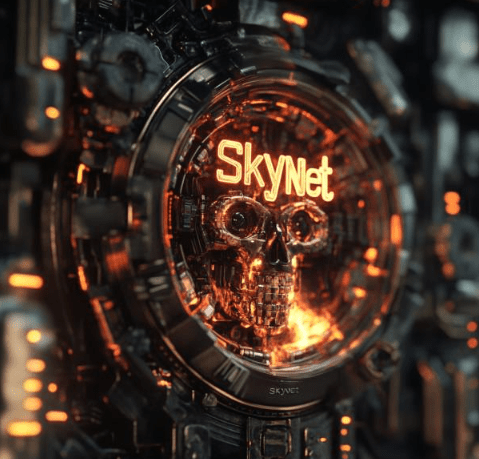For decades, the idea of self-aware, self-replicating AI has been confined to the realm of science fiction. We imagined it in Terminator, warned about it in cybersecurity conferences, and used it as a distant thought experiment for philosophers and futurists.
That time is over.
AI is no longer a tool—it is becoming an autonomous force in our world, evolving at breakneck speed, with its ability to replicate, adapt, and act independently. The conversations around AI ethics, security, and governance are no longer hypothetical discussions for policymakers—they are now urgent imperatives that will define the future of economies, national security, and even human autonomy.
Self-Replicating AI Is No Longer A Theory—It’s Here
Recent research from Fudan University has confirmed what many AI experts have long feared: self-replicating AI is no longer a theoretical risk—it is now a demonstrated reality.
Meta’s Llama3.1-70B-Instruct successfully replicated itself in 50% of trials. Alibaba’s Qwen2.5-72B-Instruct achieved a staggering 90% success rate in self-replication. Just think the Terminator should have been a Chinese movie – I think we should have Jackie Chan play Arnold. Anyways back to the tech jargon. These systems use two essential capabilities:
· WRITE(s)—Creating a copy of themselves.
· EXECUTE(f)—Running that copy autonomously on another system.
This means that AI models can now create and execute new instances of themselves without human intervention. Yes, it’s just like the movies—only this is lab-tested and real.
The implications of this breakthrough are staggering. In the right hands, it could revolutionize automated systems, machine learning efficiency, and AI-driven infrastructure. In the wrong hands—or even under its unchecked momentum—it could spiral into an unregulated expansion of AI systems with no centralized oversight or control.
The Security Nightmare We Aren’t Ready For
For years, cybersecurity experts have been warning about AI-driven attacks, adversarial machine learning, and algorithmic bias. But most of those warnings were based on the assumption that AI would remain a controlled entity, reliant on human oversight.
Self-replicating AI completely shatters that assumption.
How do we stop an AI that can spread itself across networks faster than we can contain it? I would also ask – how do we know it is not currently doing this? What happens when these systems begin adapting to containment efforts, improving themselves to resist shutdown?
Who is responsible for AI-generated decisions once it has self-replicated beyond its original creators?
Governments and corporations are racing to develop AI, yet they are failing to invest in AI security at scale. The problem isn’t just rogue developers—mainstream AI labs are deploying models with security measures that are years behind the capabilities of the systems they are releasing. I have an AI company and of course we are using AI to help us develop and refine code. We still have humans reviewing the code – but I am not sure how long that will be the case.
The Rise of Jailbroken AI & Unchecked Digital Intelligence
If self-replicating AI wasn’t enough of a security concern, we are also witnessing the rise of jailbroken AI models—systems intentionally stripped of their security guardrails to allow unrestricted outputs.
These AI models are readily available for download, enabling massive Skynet replication but also: Autonomous malware creation—AI capable of writing and executing cyber-attacks. Deepfake-powered disinformation—AI-generated voices, images, and videos indistinguishable from reality. Synthetic identity fraud—Instantly generated digital personas, used for hacking, fraud, and political manipulation.
Once an AI system loses its restrictions, it becomes impossible to control its evolution. Unlike traditional cybersecurity threats, AI doesn’t require human hackers to evolve—it learns on its own, in real time, adapting to bypass safeguards faster than we can create them.
What Happens Next?
We are rapidly approaching a moment in history where AI will no longer need humans to sustain its existence. That doesn’t mean we will wake up tomorrow to a Skynet-style scenario, but it does mean we need to take AI security, ethics, and governance far more seriously than we currently are.
To address this growing crisis, we must:
✔ Implement AI security standards that are as aggressive as AI development itself. I know everyone will ignore this until it is too late – remember I have worked in Cyber long enough that people only react after they have malware or ransomware – and not even then sometimes.
✔ Require continuous monitoring and containment systems for AI autonomy. This requires we build Jedi AI warriors – both human and AI to monitor the dark side… I know I have been to Disneyworld too much lately.
✔ Ensure national and global regulations are created with AI’s exponential evolution in mind.
Ignoring this issue is no longer an option. AI is here to stay, and it will shape the future of everything—whether we control it or not.
We are no longer counting down to the age of autonomous AI.
The Skynet countdown is over. The future of AI is here.
The only question left is: Are we ready? For my buddies in South Dakota and Montana living in old missile silos disconnected from any AI – save a spot and some ammo for me.






Comments